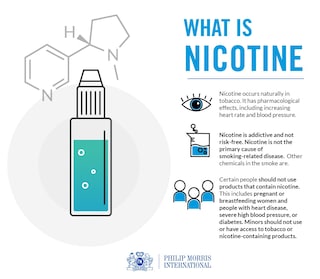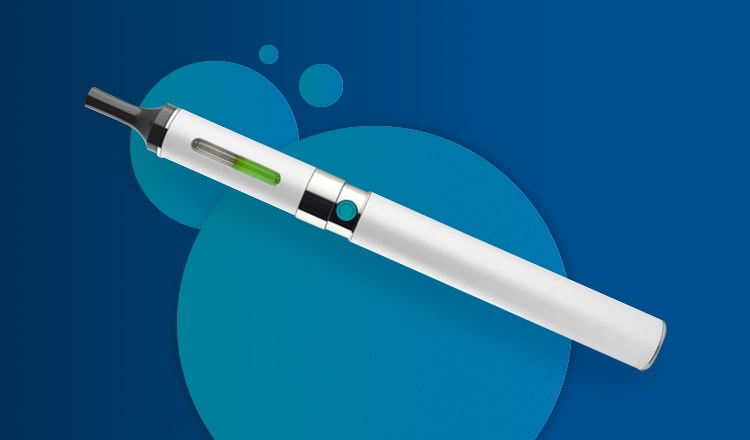Answers to commonly asked questions about better alternatives to smoking. Learn more about vapes, e-cigarettes, heated tobacco products, and oral smokeless products, including nicotine pouches and snus.
Contents
1. Are better alternatives to smoking different to cigarettes?
2. Are all better alternatives to smoking the same?
3. Do better alternatives to smoking contain nicotine?
4. Is nicotine the main cause of smoking-related diseases?
5. Is vaping addictive?
6. Heated tobacco products use tobacco. Aren’t they the same as cigarettes?
7. Do better alternatives to smoking carry a risk?
8. Is nicotine risk-free?
9. Are heated tobacco products and vapes better than continuing to smoke?
10. Do heated tobacco products and vapes give off smoke?
11. Fewer people are taking up smoking, so do we need better alternatives to smoking?
12. Do PMI’s heated tobacco products and e-cigarettes create second-hand smoke?
13. Does PMI add synthetic nicotine to its smoke-free products?
14. Is there genuine science behind PMI’s better alternatives to smoking?
15. Do PMI’s e-cigarettes and heated tobacco products contain tar?
16. Are oral smokeless products—such as nicotine pouches and snus—better than continuing to smoke?
1. Are better alternatives to smoking different to cigarettes?
2. Are all better alternatives to smoking the same?
No, there are actually a number of differences—and some similarities—between heated tobacco devices (also known as heat-not-burn products), and e-cigarettes (also known as vapes, e-vapor products, and Electronic Nicotine Delivery Systems). They are all better alternatives to the continued use of cigarettes. But heated tobacco products heat real tobacco within a specific temperature range, generally using an electronic heat-control system to prevent it from burning. E-cigarettes, by contrast, usually vaporize a liquid solution containing nicotine and flavors when a user draws on it.
3. Do better alternatives to smoking contain nicotine?
See also questions 4 and 8.
4. Is nicotine the main cause of smoking-related diseases?
See also questions 3 and 8.
5. Is vaping addictive?

What is nicotine?
Percussion music starts
Title: What is nicotine
Nicotine occurs naturally in tobacco leaves and can be extracted by heating, burning or soaking the plant
Nicotine is addictive but is it not the primary cause of smoking related diseases.
Once inhaled, it is absorbed straight into the bloodstream where it travels through the body and to the brain
Nicotine binds itself to specific receptors and triggers the release of dopamine, which boosts attention but could also cause reward-seeking behavior.
Nicotine has short-term pharmacological effects, including increased heart rate and blood pressure.
It can take anywhere between 2 and 18 hours for nicotine to leave the body.
Nicotine should never be taken by adolescents, pregnant women or people with heart conditions
The best choice any smoker can make is to quit cigarettes and nicotine use altogether.
Smoke-free alternatives are only for adult smokers who would otherwise continue smoking.
They are not risk-free and contain nicotine, which is addictive.
Music ends
6. Heated tobacco products use tobacco. Aren’t they the same as cigarettes?
No, heated tobacco products are different from cigarettes. They heat real tobacco within a specific temperature range, usually using an electronic heat-control system, to prevent it from burning. The user inhales a tobacco vapor, not smoke.
When lit, cigarettes burn tobacco at temperatures above 600°C, flaring to more than 800°C when a smoker takes a puff. In the process, they create smoke, ash, tar, and high levels of harmful chemicals.
By eliminating combustion, scientifically substantiated heated tobacco products, while not risk free, are designed to significantly reduce the levels of harmful chemicals compared to cigarette smoke.
See also questions 10 and 16.
7. Do better alternatives to smoking carry a risk?
8. Is nicotine risk-free?
9. Are heated tobacco products and vapes better than continuing to smoke?
10. Do heated tobacco products and vapes give off smoke?
No, What may appear to be “smoke” emitting from a vape or heated tobacco product is actually an aerosol, which is a suspension of fine liquid and/or solid particles in a gas (usually air). Heated tobacco products and vapes do not emit smoke, as they have not burned the tobacco.
Cigarettes burn tobacco, which creates smoke, which is also an aerosol. However, the composition of the aerosol in smoke is very different from the aerosol emitted by heated tobacco products and vapes, as smoke contains thousands of chemicals, of which around a hundred have been identified as harmful or potentially harmful.
11. Fewer people are taking up smoking, so do we need better alternatives to smoking?
Yes, through the work of government regulation and public health campaigns, smoking prevalence declined 4.1 percent in the decade between 2005 and 2015, according to the World Health Organization. Yet despite these efforts, millions of people who understand the risks continue to smoke cigarettes. According to WHO estimates, more than one billion people will still be smoking in 2025, roughly the same number as today. Nine out of 10 smokers will continue to smoke in any given year.
Our advice is that if you don’t smoke, don’t start. If you smoke, quit. If you don’t quit, change.
12. Do PMI’s heated tobacco products and e-cigarettes create second-hand smoke?
13. Does PMI add synthetic nicotine to its better alternatives to smoking?
No, in our heated tobacco products, the nicotine is not added. It is natural component of the tobacco which is heated in our product. No extra nicotine is added.
In our e-cigarettes, the nicotine-forming part is a botanical extract made from tobacco plants which is added to the e-liquid.

What's the difference between smoke and aerosol?
Title: What’s the difference between smoke and aerosol?
Dr Serge Maedar, PhD in Chemistry, Global Head of Product Research, speaks to camera:
Smoke is really the result of combustion
so it contains a number of things, a great number of constituents,
a certain number of toxicants, but it also contains for example solid particles.
Aerosol on the other hand are much simpler when they are produced by heating tobacco,
they contains less compounds in general reduced, levels of toxicants and no solid particles
so these are very different species: smoke and aerosol
Or if you look at deeper the composition and all the components these are very different things
and really one is associated with combustion while the other is not associated with combustion at all
Text on screen reads: Smoke-free products are for adult smokers who would otherwise continue smoking.
They are not risk-free and contain nicotine, which is addictive.
The best choice nay smoker can make is to quit cigarettes and nicotine altogether.
Philip Morris International logo is seen on screen.
14. Is there genuine science behind PMI’s better alternatives to smoking?
Yes, Philip Morris International (PMI) has invested more than USD 12.5 billion in research and development to offer better alternatives to smokers who don’t otherwise quit nicotine.
PMI has recruited talent from around the world to develop a hub of innovation at its R&D facility in Neuchâtel, Switzerland.
Since 2008, PMI has published more than 532 publications and book chapters related to its smoke-free products in peer-reviewed scientific journals. It registers all its clinical studies with ClinicalTrials.gov. It also publishes a Scientific Update—a summary of the latest research and developments relating to its better alternatives to smoking.
15. Do PMI’s e-cigarettes and heated tobacco products contain tar?
No, one of the most harmful elements of cigarette smoke is what many people refer to as “tar.” It is the residue from cigarette smoke after a cigarette is burned, and is more correctly called Nicotine-Free Dry Particulate Matter (NFDPM), as it is measured by the weight of solid and liquid residue in cigarette smoke after the weight of nicotine and water has been subtracted.
Tar is not present in the aerosol of our e-cigarettes or heated tobacco products. Since these products do not burn the tobacco, they do not produce tar. Their aerosol residue is fundamentally different from cigarette tar. Importantly though, this
does not mean our better alternatives to smoking are risk-free.
16. Are oral smokeless products—such as nicotine pouches and snus—better than continuing to smoke?
Yes. Our nicotine pouches and snus are not risk-free but represent a far better choice for adult smokers than continuing to smoke cigarettes.
Share this article





